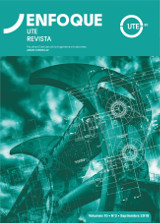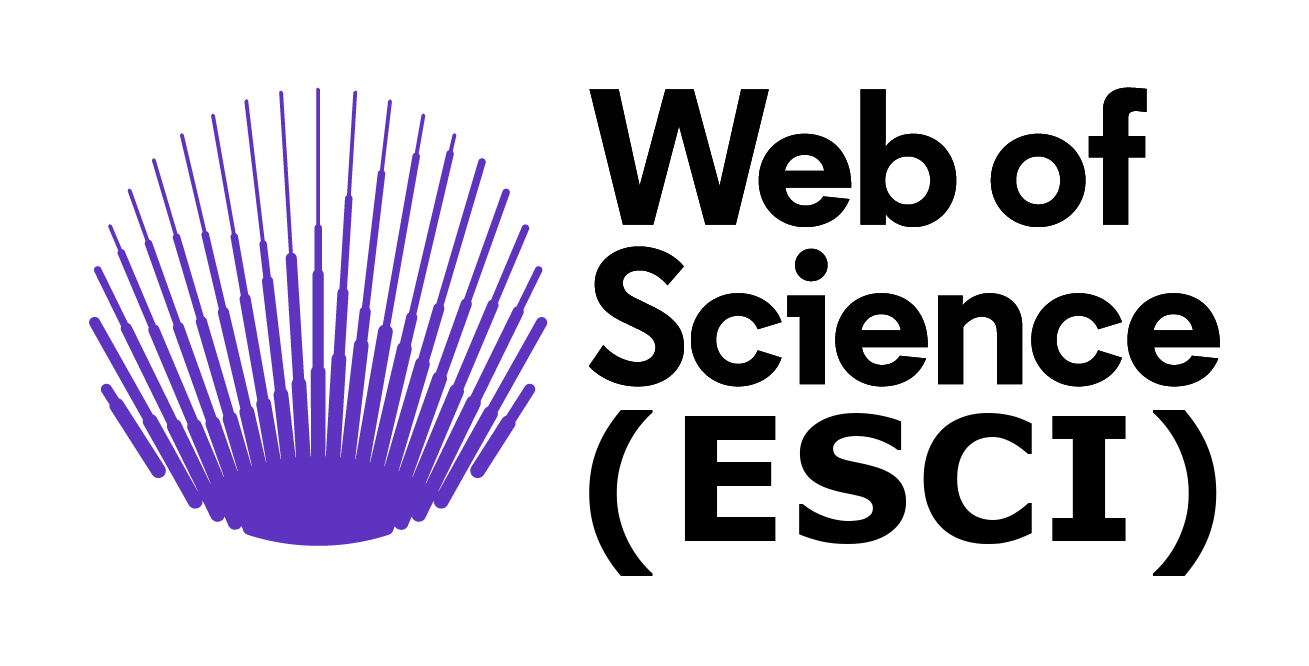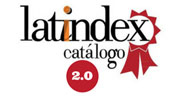Parametric Analysis of BFOA for Minimization Problems Using a Benchmark Function
DOI:
https://doi.org/10.29019/enfoque.v10n3.490Keywords:
metaheuristics, bacterial foraging optimization algorithm, chemotaxis, optimization algorithm, benchmark functionAbstract
This paper presents the social foraging behavior of Escherichia coli (E. Coli) bacteria based on Bacteria Foraging Optimization algorithms (BFOA) to find optimization and distributed control values. The search strategy for E. coli is very complex to express and the dynamics of the simulated chemotaxis stage in BFOA is analyzed with the help of a simple mathematical model. The methodology starts from a detailed analysis of the parameters of bacterial swimming and tumbling (C) and the probability of elimination and dispersion (Ped), then an adaptive variant of BFOA is proposed, in which the size of the chemotherapeutic step is adjusted according to the current suitability of a virtual bacterium. To evaluate the performance of the algorithm in obtaining optimal values, the resolution was applied to one of the benchmark functions, in this case the Ackley minimization function, a comparative analysis of the BFOA is then performed. The simulation results have shown the validity of the optimal values (minimum or maximum) obtained on a specific function for real world problems, with a function belonging to the benchmark group of optimization functions.
Downloads
References
Dorigo, M., Di Caro, G., y Gambardella, L. (1999). Ant algorithms for discrete optimization. Artificial Life, 137-172.
Salleh, M., Hussain, K., Cheng, S., Shi, Y., Muhammad, A., Ullah, G., y Naseem, R. (2018). Exploration and Exploitation Measurement in Swarm-Based Metaheuristic Algorithms: An Empirical Analysis. Recent Advances on Soft Computing and Data Mining, 24-32. doi:https://doi.org/10.1007/978-3-319-72550-5_3
Yao , X., y Liu, Y. (1998). Scaling up evolutionary programming algorithms. roceedings of the 7th Annual Conference on Evolutionary Programming, 103-112.
Biswas, A., Dasgupta, S., Das, S., y Abraham, A. (2007). A Synergy of PSO and Bacterial Foraging Optimization For Global —a comparative study on numerical benchmarks. Proceedings of the 2nd International Sympium on Hybrid Artificial Intelligence Systems (HAIS): Advances Soft Computing, 255-263.
Dorigo, M., Maniezzo, V., y Colorni, A. (1996). Ant System: Optimization by a Colony of Cooperating Agents. IEEE Transactions on Systems, 36 (1): 29-41.
Eberchart , R., y Kennedy, J. (1995). A new optimizer using particle swarm theory. Proceeding of the 6th International Symposium on Micromachine and Human Science, 39-43.
Elsisi, M. (2019). Future search algorithm for optimization. Evol. Intelligence, 12 (1): 21-31. doi:https://doi.org/10.1007/s12065-018-0172-2
Feng, X., He, Y., Yang, H., y Juan, Y. (2016). Self-adaptive bacterial foraging optimization algorithm based on evolution strategies. Revista Tecnica de la Facultad de Ingenieria Universidad del Zulia, 350-358. doi:10.21311/001.39.8.43
Floudas, C. (2000). Deterministic Global Optimization Theory, Methods and Applications. Boston, EE. UU.: Springer US.
Guang-Yu, Z., y Wei-Bo, Z. (2017). Optimal foraging algorithm for global optimization. Applied Soft Computing Journal, 51, 294-313. doi:http://dx.doi.org/10.1016/j.asoc.2016.11.047
Holland, J. (1975). Adaptation in Natural and Artificial Systems. Michigan: University of Michigan Press.
Kim, D., y Cho, J. (2005). Adaptive tuning of PID controller for multivariable system using bacterial foraging based optimization. Proceedings of the 3rd International Atlantic Web Intelligence Conference on Advances in Web Intelligence, 231-235.
Mahapatra, G., y Banerjee, S. (2015). An object-oriented implementation of bacteria foraging system for data clustering application. International Conference and Workshop on Computing and Communication (IEMCON), 1-7. doi:doi: 10.1109/IEMCON.2015.7344430
Mishra, S. (2005). A Hybrid Least Square-Fuzzy Bacterial Foraging Strategy for Harmonic Estimation. IEEE Transactions on Evolutionary Computation, 9 (1): 61-73.
Muller, S., Marchetto, J., Airaghi, S., y Ko, P. (2002). Optimization based on bacterial chemotaxis. IEEE Transactions on Evolutionary Computation, 16-29.
Najarro, R., López, R., Racines, R., y Puris, A. (2017). An Hybrid Genetic Algorithm to Optimization of Flow Shop Scheduling Problems under Real Environments Constraints. Enfoque UTE, 8 (5): 14-25. doi:https://doi.org/https://doi.org/10.29019/enfoqueute.v8n5.176
Passino, K. M. (2002). Biomimicry of bacterial foraging for distributed optimization and control. IEEE Control Systems Magazine, 52-67.
Rivero Peña, Y., Novoa Hernández, P., y Fernández Ochoa, Y. (2015). Evolutionary multi-objective optimization for software development teams building: a way of obtaining quality in the final product. Enfoque UTE, 6(1): 35-44. doi:https://doi.org/https://doi.org/10.29019/enfoqueute.v6n1.53
Sharma, A., y Kau, M. (2015). Comparative Analysis of Particle Swarm Optimization and Particle Swarm Optimization with Aging Leader and Challengers towards Benchmark Functions. International Journal of Computer Applications, 120 (24): 48-53.
Spall, J. C. (2003). Introduction to Stochastic Search and Optimization: Estimation, Simulation, and Control. Nueva Jersey: Wiley-Interscience.
Tripathy, M., Mishra, S., Lai, L., y Zhan, Q. (2006). Transmission loss reduction based on FACTS and bacteria foraging algorithm. Proceedings of the 9th International Conference on Parallel Problem Solving from Nature, 222-231.
Viera Carcache, O., Vinces Llaguno, L., Guerrero Goyes, K., y Marcillo Vera, F. (2017). Applying Ant Colony Optimization to the Problem of Cell Planning in Mobile Telephone System Radio Network. Enfoque UTE, 8 (2): 56-65. doi:https://doi.org/https://doi.org/10.29019/enfoqueute.v8n2.156
Wang, L., Zhao, W., Tian, Y., y Pan, G. (2018). A bare bones bacterial foraging optimization algorithm. Cognitive Systems Research, 52: 301-311. doi:10.1016/j.cogsys.2018.07.022
Yıldız, Y., y Altun, O. (2015). Hybrid achievement oriented computational chemotaxis in bacterial foraging optimization: a comparative study on numerical benchmark. Soft Computing, 3647-3663. doi:https://doi.org/10.1007/s00500-015-1687-4
Zhang, Q., Chen, H., Luo, J., y Xu, Y. (2018). Chaos enhanced bacterial foraging optimization for global optimization. IEEE Access, 6: 64905-64919.
Zhou, C., Yang, Y., y Wang, Y. (2019). DV-Hop localization algorithm based on bacterial foraging optimization for wireless multimedia sensor networks. Multimedia Tools and Applications, 4299-4309. doi:https://doi.org/10.1007/s11042-018-5674-5
Published
How to Cite
Issue
Section
License
Copyright (c) 2019 Enfoque UTE

This work is licensed under a Creative Commons Attribution 3.0 Unported License.
The articles and research published by the UTE University are carried out under the Open Access regime in electronic format. This means that all content is freely available without charge to the user or his/her institution. Users are allowed to read, download, copy, distribute, print, search, or link to the full texts of the articles, or use them for any other lawful purpose, without asking prior permission from the publisher or the author. This is in accordance with the BOAI definition of open access. By submitting an article to any of the scientific journals of the UTE University, the author or authors accept these conditions.
The UTE applies the Creative Commons Attribution (CC-BY) license to articles in its scientific journals. Under this open access license, as an author you agree that anyone may reuse your article in whole or in part for any purpose, free of charge, including commercial purposes. Anyone can copy, distribute or reuse the content as long as the author and original source are correctly cited. This facilitates freedom of reuse and also ensures that content can be extracted without barriers for research needs.
This work is licensed under a Creative Commons Attribution 3.0 International (CC BY 3.0).
The Enfoque UTE journal guarantees and declares that authors always retain all copyrights and full publishing rights without restrictions [© The Author(s)]. Acknowledgment (BY): Any exploitation of the work is allowed, including a commercial purpose, as well as the creation of derivative works, the distribution of which is also allowed without any restriction.























 Enfoque UTE - Facultad de Ciencias de la Ingeniería e Industrias - Universidad UTE
Enfoque UTE - Facultad de Ciencias de la Ingeniería e Industrias - Universidad UTE